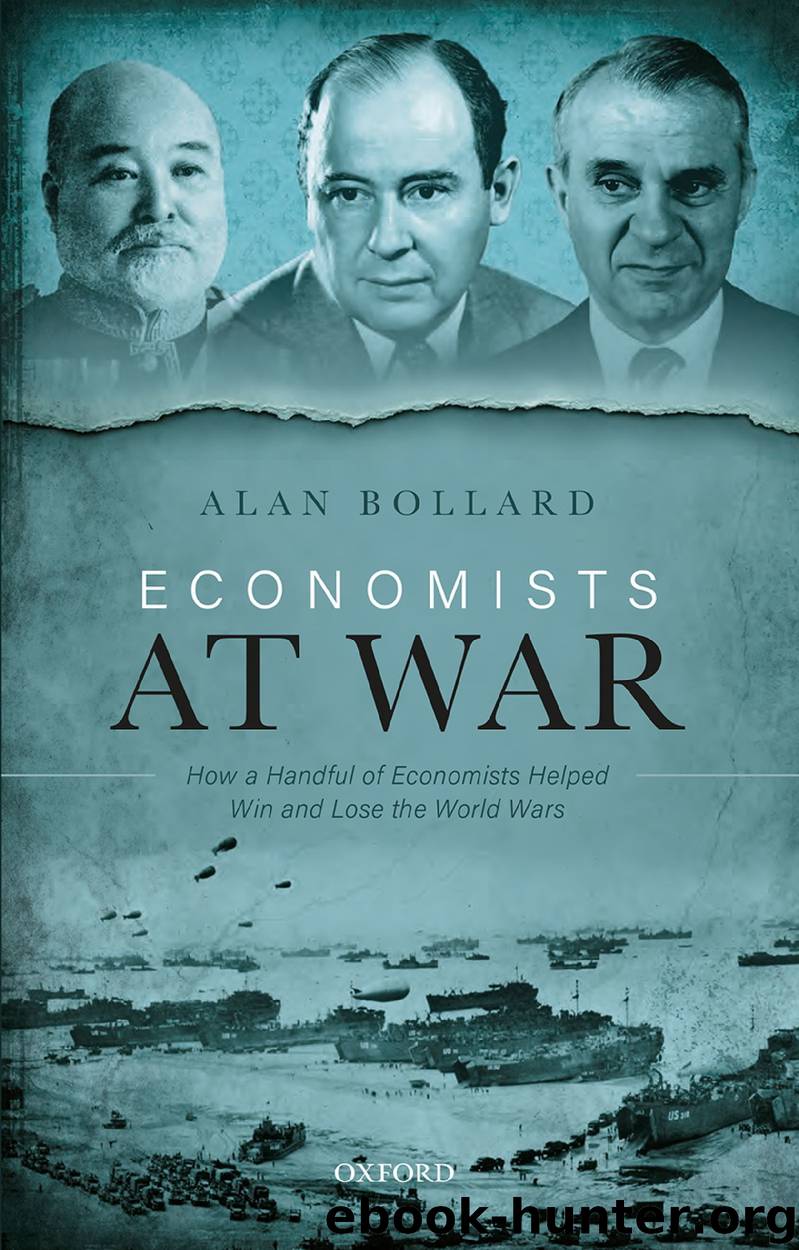Economists at War by Alan Bollard

Author:Alan Bollard [Bollard, Alan]
Language: eng
Format: epub
ISBN: 9780192584847
Publisher: OUP Oxford
Published: 2019-11-18T00:00:00+00:00
1942: The Best Use of Economic Resources
Prior to World War II the Soviet Union economy had been in poor shape to resist a military invasion, due to the disruptions of the 1920s civil war, the forced collectivization and famines of the 1930s, the purges of military leaders, and industrialization plans that focused only on West Russian economic development. The German invasion was earth-scorching, and by 1942 the Soviets were in retreat, defending desperately, with resources pillaged and factories razed to the ground. The Germans occupied over half of the Soviet Union’s cultivated land, and controlled 70 per cent of pig iron, 60 per cent of steel, and 40 per cent of electricity production. Life was very tough, the military had suffered many defeats, supplies and armaments were near exhaustion, the economy running down: there was no assurance that the Soviets could continue to fight.
The Soviet Government responded by ruthlessly diverting their remaining resources to military purposes; by the end of 1942 rifle production had quadrupled, while tanks, artillery, and plane production had increased even more. Directives from Moscow ordered the mass relocation of industry to the safer eastern regions of the Soviet Union, increased compulsory mobilization of people, and requisitioned all factories. There was severe rationing and major restrictions on consumption (pre-1940 levels of household spending were almost halved during the war). In addition, the Soviet Union received assistance from the West: a trickle of military aid at first, then from 1943 motor vehicles, high-grade fuel, communications equipment, industrial machinery, naval vessels, and processed foods. Direct controls resulted in defence spending doubling its share of the government’s budget to a massive 60 per cent by 1942. By this time three-quarters of national income and most of the working population were devoted to war.
Economic planning in the Soviet Union since the 1930s had borne some similarity to planning in Nazi Germany, both using fixed prices, military mobilization, economic coercion, forms of market socialism, and consumption being sacrificed to investment and heavy industry. Germany under-priced capital but the Soviet Union made it available to enterprises without any cost. The Soviet Union’s five-year plans were more specific, but central planning there was not as coherent as this might have suggested: the economy was more agrarian and primitive, prices were not used or were arbitrarily set to equal costs, and hence offered poor signals, and there was use of terror and show trials to discipline poor managers. There was extreme centralization and vertical decision-making, with decisions being delegated upwards by the managers who actually knew the issues, for decision by their superiors, due to the atmosphere of fear and suspicion. Decisions on the allocation of resources were made by individual members of Stalin’s cabinet directly led by the dictator himself.
In the midst of this wartime drama and disruption, an important meeting of top Soviet economists took place in Stalin’s office in the Kremlin on 29 January 1941 for an hour and a half. At Stalin’s direction the Soviet Union Central Committee had commissioned a textbook on the Soviet political economy.
Download
This site does not store any files on its server. We only index and link to content provided by other sites. Please contact the content providers to delete copyright contents if any and email us, we'll remove relevant links or contents immediately.
International Integration of the Brazilian Economy by Elias C. Grivoyannis(90719)
The Radium Girls by Kate Moore(11921)
Turbulence by E. J. Noyes(7935)
Nudge - Improving Decisions about Health, Wealth, and Happiness by Thaler Sunstein(7615)
The Black Swan by Nassim Nicholas Taleb(7010)
Rich Dad Poor Dad by Robert T. Kiyosaki(6399)
Pioneering Portfolio Management by David F. Swensen(6226)
Man-made Catastrophes and Risk Information Concealment by Dmitry Chernov & Didier Sornette(5921)
Zero to One by Peter Thiel(5684)
Secrecy World by Jake Bernstein(4642)
Millionaire: The Philanderer, Gambler, and Duelist Who Invented Modern Finance by Janet Gleeson(4374)
The Age of Surveillance Capitalism by Shoshana Zuboff(4209)
Skin in the Game by Nassim Nicholas Taleb(4161)
Bullshit Jobs by David Graeber(4094)
The Money Culture by Michael Lewis(4074)
Skin in the Game: Hidden Asymmetries in Daily Life by Nassim Nicholas Taleb(3929)
The Dhandho Investor by Mohnish Pabrai(3698)
The Wisdom of Finance by Mihir Desai(3650)
Blockchain Basics by Daniel Drescher(3495)
